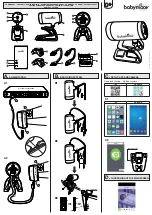
Safety Information
IMPORTANT!
Please read the following information carefully before
installing and using the BEAM IridiTRAK. Failing
to follow
instructions may compromise the safety of the product and
may
result in personal injury and/or equipment damage. Please consult
your supplier if you have any further questions.
♦
Your IridiTRAK is a low power radio transmitter and receiver. When it is ON, it
receives and sends out radio frequency (RF) signals.
♦
The design of your IridiTRAK system complies with international safety
standards.
WARNING:
DO NOT open equipment. There are no user-serviceable
parts inside.
If a DC power supply is to be used, its output must comply with the
Safety Extra Low Voltage (SELV) requirements of IEC60950, and be
within the operational DC voltage range (and power capacity) as
specified in this manual.
All connectors must only be connected to equipment ports which
comply with the Safety Extra Low Voltage (SELV) requirements of
IEC60950.
♦
Store the system in a cool and dry area.
♦
Do not submerge the system in water.
♦
Do not place foreign metal objects or debris in the system. If debris fall into
the system, please return to factory for service.
Safety – Iridium Transceiver.
♦
The IridiTRAK has an in-built Iridium transceiver which is designed to be used
with an external antenna. This antenna transmits RF energy. The Iridium
antenna (fitted via an extension coaxial cable) must be located more than >
0.3 meters (1 foot) from human body (person) when in operation.
♦
International agencies have set standards and recommendations for the
protection of public exposure to RF electromagnetic energy.
International Commission on Non-Ionizing Radiation Protection (ICNIRP) 1996
Verband Deutscher Elektrotechniker (VDE) DIN-0848
United States Federal Commission, Radio Frequency Exposure Guidelines (1996)
National Radiological Protection Board of the United Kingdom, GS 11, 1988
American National Standards Institute (ANSI) IEEE. C95. 1-1992
These standards are based on extensive scientific review. For example, over 120
scientists, engineers, and physicians from universities, government health agencies, and
industry reviewed the available body of research to develop the updated ANSI standard.
Page 5 of 46






































